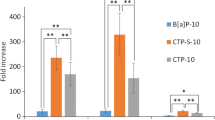The mouse skin cocarcinogens fluoranthene, pyrene, and undecane were used with the indirect-acting carcinogen, benzo(a)pyrene (BP), and the direct-acting alkylating carcinogen, ß-propiolactone (BPL), in an in vitro transformation assay. Dose response, cytotoxicity, and transformation studies with these compounds were performed with a subclone (A31-1-1) of the Balb/3T3 cell line. Transformation frequencies were found to increase with increasing concentrations of BP used up to 1.0 µg/ml or when BPL was used up to 4.0 µg/ml. A significant increase (P<0.05) in the transformation frequency over that seen with carcinogen alone was observed when cells were exposed to a combination of fluoranthene (4.0 µg/ml) and BP (0.063 µg/ml) or pyrene (5.0 µg/ml) and BP (0.063 µg/ml). Thus, the transformation frequency obtained with BP + fluoranthene was 3.8 × 10−4 compared to 1.2 × 10−4 when BP was tested alone. Similarly, the transformation frequency using BP + pyrene was 2.8 × 10−4 vs 1.2 × 10−4 when BP was tested alone. Undecane did not exert any cocarcinogenic effect with BP in the dose range tested. In this in vitro assay, no cocarcinogenic effect was observed when BPL was used with any of the above mouse skin cocarcinogens. All cells isolated from transformed foci showed characteristics of transformed cells including anchorage-independent growth.
Similar content being viewed by others
Abbreviations
- BP:
-
benzo(a)pyrene
- BPL:
-
ß-propiolactone
- CE:
-
cloning efficiency
- CE50 :
-
median CE
- RCE:
-
relative CE
References
ATCHISON, M., CHU, C.-S., KAKUNAGA, T. and VAN DUUREN, B.L. (1982a). Chemical cocarcinogenesis is a subclone of Balb/3T3 cells using catechol as cocarcinogen. J. Am. Coll. Tox. 1:116.
ATCHISON, M., CHU, C.-S., KAKUNAGA, T. and VAN DUUREN, B.L. (1982b). Chemical cocarcinogenesis with the use of a subclone derived from Balb/3T3 cells with catechol as cocarcinogen. J. Natl. Cancer Inst. 69:503–508.
BAIRD, W.M. and DIAMOND, L. (1981). Effects of the cocarcinogen benzo(e)pyrene on metabolism of the carcinogen benzo(a)pyrene in hamster embryo cell cultures. Proc. Am. Assoc. Cancer Res. 22:96.
BERENBLUM, I. (1941). The mechanism of carcinogenesis. A study of the significance of cocarcinogenic action and related phenomena. Cancer Res. 1:807–814.
KAKUNAGA, T. (1973). A quantitative system for assay of malignant transformation by chemical carcinogens using a clone derived from Balb/3T3. Int. J. Cancer 12:463–473.
KAKUNAGA, T. (1975). The role of cell division in the malignant transformation of mouse cells treated with 3 3-methylcholanthrene. Cancer Res. 35:1637–1642.
KAKUNAGA, T. (1978). Factors affecting polycyclic hydrocarbon-induced cell transformation. In: Polycyclic Hydrocarbons and Cancer (Gelboin, H.V. and Tso, P.O.P., eds.) pp. 293–304. Academic Press, New York, N.Y.
KAKUNAGA, T. and CROW, J.D. (1980). Cell variants showing differential susceptibility to ultraviolet light-induced transformation. Science 209:505–507.
LEE, S.D. and GRANT, L. (1981). Health and ecological assessment of polynuclear aromatic hydrocarbons. J. Env. Path. and Toxicology 5:1–364.
MACPHERSON, I. and MONTAGNIER, L. (1964). Agar suspension culture for the selective assay of cells transformed by polyoma virus. Virology 23:291–294.
MECHIONNE, S., AGARWAL, S.C., VAN DUUREN, B.L. and SEIDMAN, I. (1982). Cocarcinogenesis and two-stage carcinogenesis in ICR/Ha and Sencar mice. J. Am. Coll. Tox. 1:116.
NESNOW, S., LEAVITT, S. and GARLAND, H. (1981). Identification of cocarcinogens and their potential mechanisms of action using C3H/10T 1/2/CL8 mouse embryo fibroblasts Cancer Res. 41:3071–3076.
PUCK, T.T., MARCUS, P.I. and CIECIURA, S.J. (1956). Clonal growth of mammalian cells in vitro. Growth characteristics of colonies from single HeLa cells with and without “feeder layer”. J. Exp Med. 103:273–284.
TOPPING, D.C., MARTIN, D.H. and NETTESHEIM, P. (1981). Determination of cocarcinogenic activity of benzo(a)pyrene for respiratory tract mucosa. Cancer Lett. 11:315–321.
VAN DUUREN, B.L. (1958). Identification of some polynuclear aromatic hydrocarbons in cigarette-smoke condensate. J. Natl. Cancer Inst. 21:1–16.
VAN DUUREN, B.L. and GOLDSCHMIDT, B.M. (1966). Carcinogenicity of epoxides, lactones, and peroxy compounds. III. Biological activity and chemical reactivity. J. Med. Chem. 9:77–79.
VAN DUUREN, B.L., KATZ, C. and GOLDSCHMIDT, B.M. (1973). Brief Communication: Cocarcinogenic agents in tobacco carcinogenesis. J. Natl. Cancer Inst. 51:703–705.
VAN DUUREN, B.L. and GOLDSCHMIDT, B.M. (1976). Cocarcinogenic and tumor promoting agents in tobacco carcinogenesis. J. Natl. Cancer Inst. 56:1237–1242.
VAN DUUREN, B.L. and MELCHIONNE, S. (1980). Cofactors in environmental health and disease: Cocarcinogens and tumor promoters, Chapter 17. In: Environmental Health Chemistry. (McKinney J., Ed., ed.) The Chemistry of Environmental Agents as Potential Human Hazards. pp. 337–364. Ann Arbor Sci. Publ., Ann Arbor, Mich.
WYNDER, E.L. and HOFFMANN, D. (1967). Tobacco and Tobacco Smoke, pp. 330–350, Academic Press, New York.
Author information
Authors and Affiliations
Additional information
Department of Cell Biology, New York University Medical Center
Institute for Cancer Research, Fox Chase Cancer Center, Philadelphia, PA.
Contribution No. L217 from the Laboratory of Organic Chemistry and Carcinogenesis.
Rights and permissions
About this article
Cite this article
Atchison, M., Atchison, M.L. & Van Duuren, B.L. Cocarcinogenesis in vitro using Balb/3T3 cells and aromatic hydrocarbon cocarcinogens. Cell Biol Toxicol 1, 323–331 (1985). https://doi.org/10.1007/BF00118197
Received:
Accepted:
Issue Date:
DOI: https://doi.org/10.1007/BF00118197




